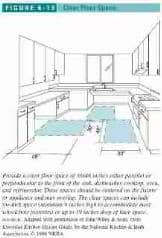 Accessible Kitchen Design: Best Practices
Accessible Kitchen Design: Best Practices Accessible Kitchen Design: Best Practices
Accessible Kitchen Design: Best PracticesThis article describes the layout and specifications for accessible kitchens and kitchen work spaces. We cover Accessible kitchen work aisles, passageways. Knee space requirements for accessible kitchens.
Clear floor space specifications for accessible kitchens. Counter & appliance height in accessible kitchens. Storage height, handles, & controls for accessible kitchen design.
Sink & dishwasher work center design for accessible kitchens. Refrigerator work space for accessible kitchen design
InspectAPedia tolerates no conflicts of interest. We have no relationship with advertisers, products, or services discussed at this website.
- Daniel Friedman, Editor/Publisher - See WHO ARE WE?
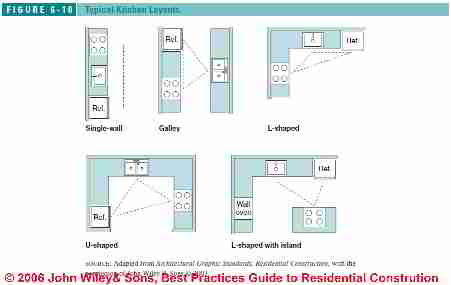
This article series discusses current best design practices for kitchens and bathrooms, including layout, clearances, work space, and accessible kitchen and bathroom layout, clearances, turning space, grab bars, controls, etc.
[Click to enlarge any image]
We include advice on choosing and installing kitchen countertops, cabinets, and kitchen or bathroom flooring, sinks, and other plumbing fixtures and fixture controls such as faucets. A list of kitchen and bath product manufactures and sources is included.
As described in detail in Chapter 6 of Best Practices Guide to Residential Construction (Steve Bliss, J Wiley & Sons) :
To make a kitchen fully functional for wheelchair users and other seated occupants requires simple commonsense changes, like placing knobs within reach, as well as more significant changes, such as lowering counters and providing knee space below.
The guidelines below, based on ANSI (American National Standards Institute) A117.1 standards, are a good starting point in design, but they should be tailored to the size, reach, and specific capabilities of the occupants.
Clear space at doorways and passageways must be at least 32 inches wide and no more than 24 inches long in the direction of travel. Eliminate any thresholds at doorways.
The minimum work aisle with counters or appliances on both sides should be 40 inches.
Walkways with counters or appliances on only one side can be 36 inches wide, but if a walkway turns a corner, as in Figure 6-10 (at left), one leg of the walkway space should be widened to 42 inches for a wheelchair to make the turn.
[Click any image or table to see an enlarged version with additional detail, commentary & source citation.]
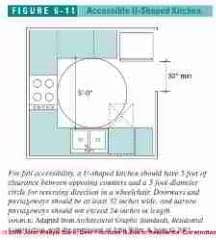
From a table or eating counter to a wall, leave 54 inches for wheelchair access.
In a U-shaped kitchen the minimum clearance between counters is 60 inches (Figure 6-11 at left).
Wherever possible, provide knee space for a seated user below or adjacent to sinks, cooktops, ranges, dishwashers, refrigerators, and ovens.
To accommodate a seated user, below-counter knee space should be a minimum of 30 inches wide, 27 inches high in front, and 19 inches deep, with a minimum 9-inch-high toe space, which will accommodate most wheelchair footrests.
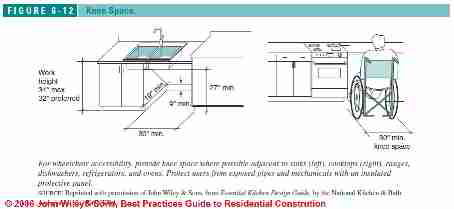
Protect users from exposed pipes and mechanicals with a protective panel and insulation (Figure 6-12 above).

To make work centers universally accessible, provide a clear floor space of 30x48 inches or 48x30 inches, centered in front of the sink, dishwasher, cooktop, oven, and refrigerator.
In an accessible (or other) kitchen design layout, clear floor spaces for different work areas may overlap, and the long dimension can include up to 19 inches deep of knee space below counters (Figure 6-13).
he optimal height for most seated occupants at counters, sinks, and cooktops is about 32 inches and should be no higher than 34 inches.
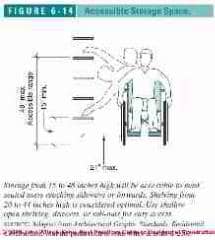
Most seated users in a kitchen can fully reach shelving located from 15 to 48 inches high.
Storage located from about 20 to 44 inches is considered optimal for accessible kitchen designs.
In an accessible-designed kitchen you should use open shelving, shelf racks on pantry doors, and drawers or roll-out shelving for easy access (Figure 6-14).
Controls, handles, and door and drawer pulls should be operable with one hand, require minimal strength, and not require tight grasping, pinching, or twisting of the wrists. Lever-action handles work well for doors and faucets. A simple test is to try to operate the controls with a closed fist.
Mount wall cabinet doors at the bottom of the cabinets and base cabinet pulls at the top of the cabinets.
Use a shallow sink mounted at 32 to 34 inches (32 preferred) with the drain in the rear so it does not interfere with knee space (Figure 6-15 below).
The garbage disposal must also be offset so it does not interfere with knee space. A tall faucet and pullout spray attachment are recommended to simplify work at the sink. Locate the dishwasher adjacent to the sink or no more than 12 inches away.
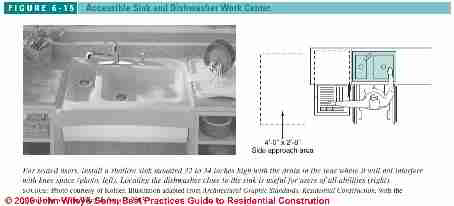
Lighting levels should be up to twice normal levels. Using light-colored floors, walls, ceilings, and counters will help keep all areas well illuminated. Light colors on the insides of cabinets and drawers will help make items more visible.
If possible, place the cooktop and sink on the same wall so users do not have to carry heavy pots across the room. Electric cooktops with a smooth surface and controls on the front work best so the user does not have to reach over the top. Look for units with staggered burners for easier access to back burners.
Use a separate wall-mounted oven, not an under-counter design. An oven with a side-hinged door rather than the usual pull-down style works well.
Side-by-side units with doors that swing back a full 180 degrees are preferable to up-and-down models. Provide at least 18 inches of counter space adjacent to the refrigerator.
- - Adapted with permission from Best Practices Guide to Residential Construction (Steve Bliss, J Wiley & Sons) . This article includes excerpts or adaptations from Best Practices Guide to Residential Construction (Steve Bliss, J Wiley & Sons) , by Steven Bliss, courtesy of Wiley & Sons.
Below in the article references section we provide a DOJ article that gives a high-level gloss on the topic of meeting the accessibility requirements for people using a power-driven motorized device - a concept more broad than only motorized wheelchairs.
Here we will collect specific suggestions for kitchen designs that need to accomodate not simply wheelchair access, but motorized wheelchair access.
Even within the category of motorized wheelchairs and excluding other power-driven mobility devices such as Segways®, motorized wheelchairs vary in dimensions, weight, speed, and turning radius as well as operating controls.
If you have additional motorized wheelchair accessibility design suggestions and/or detailed specifications, or examples of designs that work well, please CONTACT US.
ADAAG Standard wheelchair turning radius:
T-shape space: 36 inches (915 mm) wide at the top and stem within a 60 inch by 60 inch (1525 mm by 1525 mm) square.
Long back end makes turning difficult in tight spaces
Front short endmakes turning tight corners easier
May be able to turn within a circle with diameter equal to the chair length
Notes to the table:
Footrest position and design add to length of chair and thus impact turning radius
Sets out requirements for the design of buildings and facilities for access for people with disabilities. Where appropriate, these requirements are additional to the minimum requirements of AS 1428.1.
Also covers requirements for buildings and facilities which are not covered in Part 1.
The purpose of this Standard is twofold. First, it covers items which are not covered in AS 1428.1, Design for access and mobility, Part 1: General requirements for access—Buildings , and second it gives enhanced requirements for access, for reference by authorities and other users who wish to provide a greater level of accessibility than the minimum requirements of Part 1.
Whereas the requirements in Part 1 are based on research on the capabilities of 80 percent of people with disabilities in Australia who use wheelchairs, together with some recognized needs of other disability groups, the enhanced requirements in this Standard have been determined, where possible, from the researched capabilities of at least 90 percent of test subjects comprising both people who use wheelchairs and ambulant people.
Where the minimum space, dimensions and gradients of Part 1 have been shown to be suitable for 90 percent of users, the requirements of AS 1428.1 have been called up in this Standard.
The major sources for determining the requirements in this Standard are studies by J. Bails, Public Buildings Department of South Australia, 1983, and E. Steinfeld, Syracuse University, Syracuse, NY, USA, 1979.
For reach limits, reference was also made to A study of the space requirements of wheelchair users from the official journal of the International Society of Paraplegia: Paraplegia, volume 4, Number 1, May 1966.
In recommending spaces between rest areas and time allowance at traffic lights, reference was made to the ability of people to move stated distances and the movement time of people in the 1990 research report An ergonomic study of pedestrian areas for disabled people, Institute of Transport Studies, University of Leeds, UK.
The series, when complete, will comprise the following:
AS
1428 Design for access and mobility
1428.1 General requirements for access—Buildings
1428.2 Enhanced and additional requirements—Buildings and facilities (this Standard)
1428.3 Requirements for children and adolescents with physical disabilities
Special thanks to Bruce Bromley,
ADVERTISEMENT
Below you will find questions and answers previously posted on this page at its page bottom reader comment box.

Thank you for that additional suggestions: ADA-approved cabinet and drawer pulls.
Typical ADA cabinet and drawer pulls are a bar raised off of the cabinet or drawer face - I'll show those in a moment. But first, here is an interesting product, shown above:
DoorWave™ by Functional Form, LLC is a hands-free door pull that allows you to open the door with your foot, sold by https://www.ameraproducts.com/ and other vendors.
Shown below are are more-typical ADA-compliant cabinet door or drawer pulls, sold just about everywhere including at building suppliers like Lowes and Home Depot
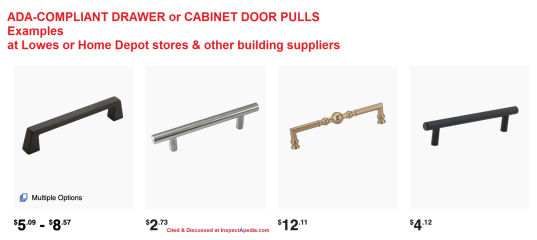
On 2021-05-25 by alain smithee
I've seen upper cabinet and lower door pulls mounted at a 45-degee angle to make them easier to grasp for an individual with arthritis. This also made it easier to open the cabinet or door using a spoon as a lever,
I'm researching the question further and; I've posted some additional information in the article above on this page and in a reader Q&A answered earlier (seen below) - you may need to clear your browser cache or wait a few hours to see the update; I'd welcome specific technical questions as well.
In general for an electric wheelchair, scooter, or reclining wheelchair users we need more turning space of these minimum dimensions:
On 2018-09-21 by Donna
I, like Wayne, am looking for kitchen specifications for a motorized wheelchair as opposed to a manual wheelchair. Have you made any progress in this area?
On 2018-04-30 by (mod)
If you have a specific question you're welcome to ask here and we'll do our best to answer. If you need an accessible design architect or builder - contractor then of course you'll need to find a local expert.
On 2018-04-30 by julia
On 2016-10-10 by (mod) - ADA space and turning area dimensions for motorized wheelchairs & wheelchair platform lifts
Thanks for the good question, Wayne.
Using 33" as a typical height from floor to top of joystick for a power wheelchair, that's 3" higher than a conventional adult wheelchair (30" from floor to top surface of arm rest).
I used the Invacare® Pronto® M41™ Power Wheelchair as the power wheelchair example.
I looked at the specifications for several elevating wheelchair models but none provided a height from armrest or joystick top to floor. Can you give me that dimension for the brand and model chair that interests you?
Good point about the dishwasher. Looking at the U.S. ADA updates last completed in 2010:
Up to 1/4" gap: no edge treatment is required
Gaps or elevation changes 1/4" to 1/2": beveled edges are required
Gaps or elevation changes greater than 1/2": provide a ramp
Carpeting, if present, must be secured at edges and have pile no higher than 1/2"
Any floor grating openings shoudl not have openings greater than 1/2" in width in any direction;
Your point is of crucial importance to wheelchair users with all wheelchair types. I'm researching further.
On 2016-10-09 by Wayne Duke
It appears your design is for manual chairs only. Have you done any work related to power wheelchairs with elevator?
It is difficult to get under counters so low. Elevated foot plates look to need a minimum of 18" vertical clearance instead of the 9" you reference.
Also unable to reach down to access dishwasher at standard height.
Thanks for any help.
Wayne
(June 7, 2012) kay said:
I thought I would need to think about this redo in about 10 years. Things changed for me in I step. This is important for everyone to think about.
(Feb 2, 2013) Anonymous said:
i remodeled my grandmother's house and added a 2d bath with a wide door, as the 'main bath door was just 18". i was planning for my mom. Overnight, my daughter needed it--fer several years. I dont see hmes the same way anymore.
Continue reading at KITCHEN CABINET DESIGN Guide or select a topic from the closely-related articles below, or see the complete ARTICLE INDEX.
KITCHEN DESIGN, ACCESSIBLE at Inspect A pedia.com - online encyclopedia of building & environmental inspection, testing, diagnosis, repair, & problem prevention advice.
Share this articleOr use the SEARCH BOX found below to Ask a Question or Search InspectApedia
Try the search box just below, or if you prefer, post a question or comment in the Comments box below and we will respond promptly.
Search the InspectApedia website
Note: appearance of your Comment below may be delayed: if your comment contains an image, photograph, web link, or text that looks to the software as if it might be a web link, your posting will appear after it has been approved by a moderator. Apologies for the delay.
Only one image can be added per comment but you can post as many comments, and therefore images, as you like.
You will not receive a notification when a response to your question has been posted.
Please bookmark this page to make it easy for you to check back for our response.
Our Comment Box is provided by Countable Web Productions countable.ca
Thanks to Alan Carson and Bob Dunlop, for permission for InspectAPedia to use text excerpts from The HOME REFERENCE BOOK - the Encyclopedia of Homes and to use illustrations from The ILLUSTRATED HOME .